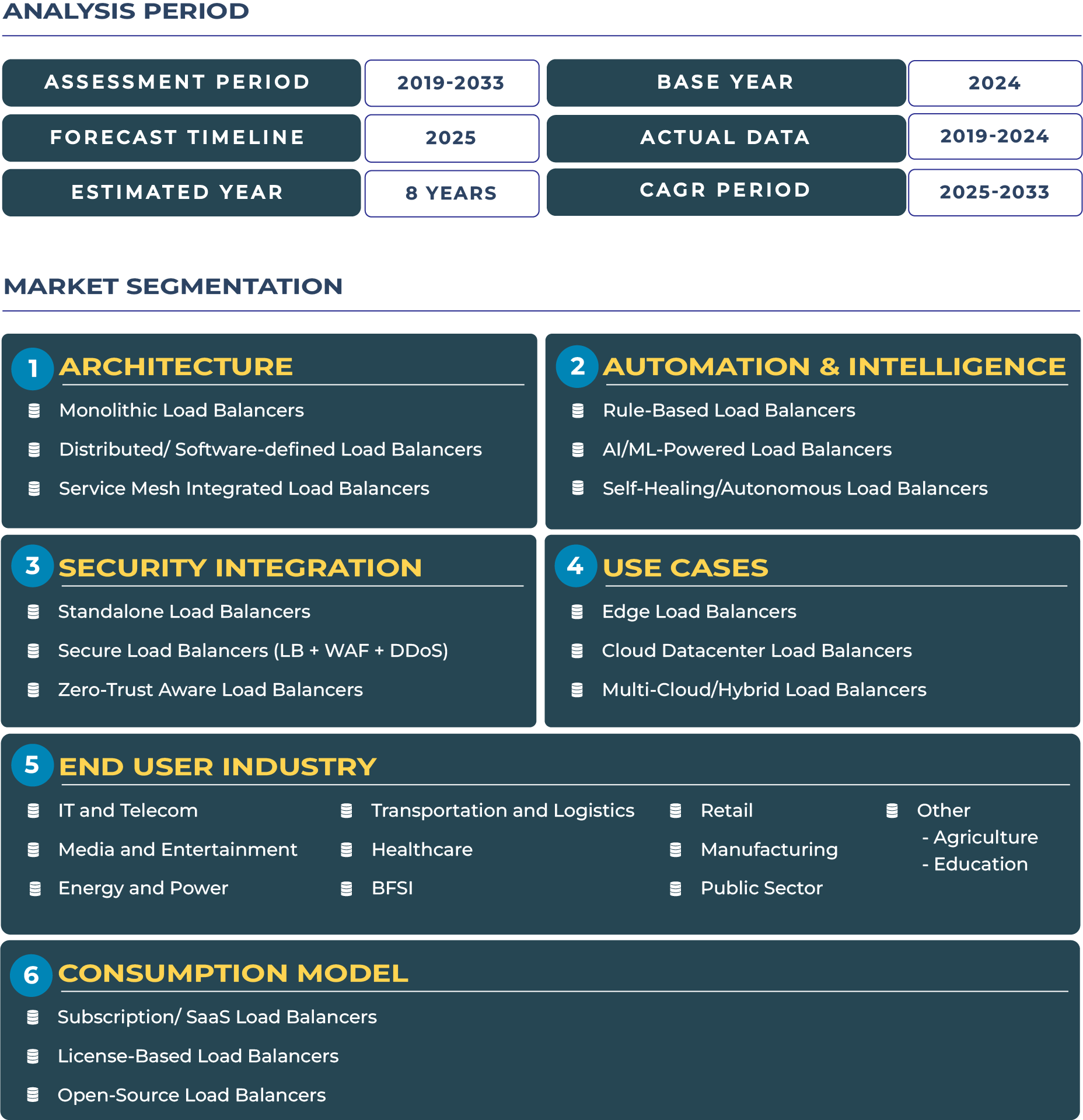ASEAN Cloud Load Balancers Market Outlook
ASEAN has emerged as one of the fastest-growing digital blocs, where digital inclusion is largely driven by small and medium-sized enterprises (SMEs) and telecom-led innovation. The region’s strategic position in cross-border digital trade, coupled with its mobile-first population, has created an enabling environment for cloud adoption. Within this ecosystem, the cloud load balancers market plays a crucial role in ensuring scalability, reliability, and performance across distributed digital services. The ASEAN Cloud Load Balancers Market is projected to expand from USD 212.0 million in 2025 to USD 907.0 million by 2033, growing at an impressive CAGR of 19.9%. This surge is powered by rapid cloud-native adoption, proliferation of digital platforms, and harmonization efforts by ASEAN governments to strengthen connectivity across borders. The rising appetite for digital payments, online marketplaces, and media streaming platforms further underscores the demand for distributed and service mesh-integrated load balancing solutions.
Dynamic Drivers and Emerging Restraints Defining ASEAN Cloud Load Balancers Industry
Several core drivers fuel the momentum of ASEAN cloud load balancers industry. A large mobile-first population across Indonesia, Vietnam, and the Philippines is spurring demand for low-latency applications, necessitating advanced load balancing mechanisms. Additionally, ASEAN’s rapidly growing e-commerce sector is becoming an anchor for digital traffic, pushing enterprises to adopt software-defined and distributed load balancers that can seamlessly manage peak traffic surges. Another critical driver is the expansion of telecom-edge investments. Major telcos in ASEAN are deploying edge data centers and cloud exchange hubs to serve local markets efficiently, creating direct opportunities for load balancer vendors.
However, growth is not without challenges. Regulatory fragmentation across ASEAN members often complicates cross-border digital infrastructure deployment. For example, data localization laws in Vietnam and Indonesia pose hurdles for multi-region cloud strategies. Infrastructure gaps in smaller members such as Laos and Cambodia continue to restrict consistent cloud adoption. Additionally, high price sensitivity among SMBs delays adoption of premium load balancing solutions, limiting addressable market potential for vendors targeting cost-conscious enterprises.
Accelerating Trends and Untapped Opportunities Shaping ASEAN’s Cloud Load Balancers Ecosystem
ASEAN’s cloud load balancers ecosystem is being reshaped by transformative trends. The convergence of telecoms and content delivery networks (CDNs) at the edge is fostering ultra-low latency service delivery. Countries like Singapore and Malaysia are piloting regional multi-cloud trials, enabling interoperability and seamless traffic routing across providers. The vibrant startup ecosystem in Indonesia and Vietnam is also accelerating adoption, where technology-first enterprises are building their infrastructure on service mesh-integrated load balancers from inception.
Opportunities are equally compelling. Telco co-sell strategies for edge load balancers present a high-value route for vendors to scale in markets like Thailand and the Philippines. There is also a growing appetite for SMB-targeted SaaS load balancers that lower entry barriers and enable SMEs to compete on digital parity with larger enterprises. Furthermore, multi-CDN plus load balancer bundles are emerging as a preferred model for regional media companies to ensure seamless video streaming during peak hours.
Competitive Landscape: Strategic Moves of Leading Cloud Load Balancer Providers in ASEAN
The cloud load balancers sector in ASEAN is characterized by both global players and local innovators. Companies like F5 Networks have established a significant footprint, leveraging partnerships with regional telcos to extend reach across multiple ASEAN markets. Local providers are aligning with managed service providers (MSPs) to deliver tailored offerings for SMEs. For instance, partnerships between regional data centers and telcos are reducing capital expenditure for vendors while expanding last-mile reach. Singapore’s government-driven digitalization initiatives, promoted by the Infocomm Media Development Authority (IMDA), have also created a fertile ground for vendors to deploy distributed and software-defined load balancing models. Key developments in 2024 include the scaling of service mesh integrations in Vietnam and Indonesia’s push for multi-cloud adoption aligned with digital sovereignty goals.








